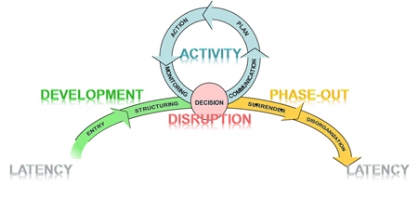Life cycle
All objects and people in the context of the corporate environment are subject to a life cycle. That way machines, programs, infrastructures as well as employees and their knowledge follow a similar course of growing, living and fading away. The handling of the specific aspects differs in each phase. Each object and subject has its own cycle. All objects are in different states at a time. These cannot be synchronized by their very nature.
Life cycle consists of five phases: Development, Disruption, Activity, Phase-out, and Latency.

Development
This is the stage of growth, where something new matures. Openness and creativity are needed, in order to arrive at viable results. Approaches can turn to be redundant and contradictory. Therefore, the development ends with the selection of the best result and the final structuring.
Disruption
In the disruption, it is decided the first time, whether the new procedure will be implemented in daily business. Regularly the question is asked again, to what extent the solution stands the test and can be continuously used. In this step, one needs criteria for evaluation that enables the decision concerning continuing or phasing out of the approach.
Activity
This is operations that runs until the phase-out will be decided. The continuous improvement of the solution extends its period of use. The particular aspect of this cycle is the exchange of opinions at the beginning that provides the relevant information to the participants, so that these can use the solution effectively.
Phase-out
After the decision is made to let something go, it should be consequently be done. The phase-out heralds the end of the solution and dissolves it steadily. The sluggishness of the organization and the people involved requires stringent disclosure of the reasons for the dissolution as well as perspectives for the employees concerned.
Latency
Even if an object or a person is no longer deployed, they are, however, still subliminally available. Through a skillful remembering, the contents of the latency can be used to consider previous functioning elements in the creation of new business elements. Rarely the wheel has to be reinvented.
